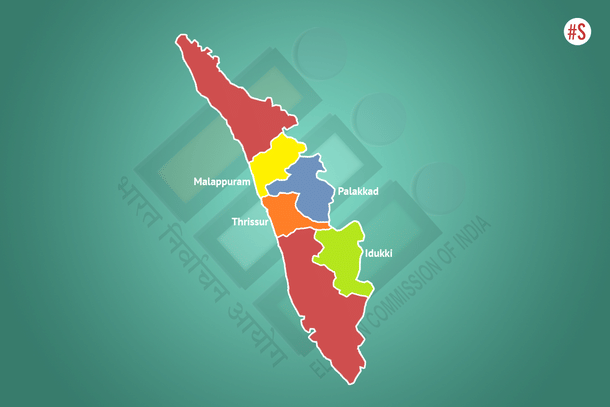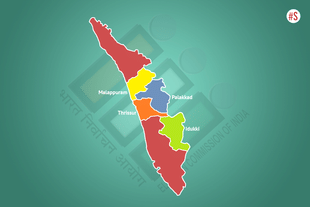Politics
South Malabar, Thrissur, And Idukki: Central Kerala Has Some Cheer For Congress
Venu Gopal Narayanan
Mar 24, 2021, 01:25 PM | Updated 01:25 PM IST
Save & read from anywhere!
Bookmark stories for easy access on any device or the Swarajya app.


In this second part of our series on the election scenario in Kerala, we review the situation in the four districts of Malappuram, Palakkad, Thrissur and Idukki. Again, the data used is from a pre-poll survey conducted by Manorama-VMR last week.
The findings are that 32 of the 46 seats in these four districts are projected to go to the Congress-led United Democratic Front (UDF), with the balance 14 going to the Pinarayi Vijayan-led Left Democratic Front (LDF) of the communists.
The Bharatiya Janata Party (BJP) and their National Democratic Alliance (NDA) constituents are not allocated any wins at present.
In Malappuram district, where Muslims are in an overwhelming majority (75-85 percent in many places), a key UDF ally, the Indian Union Muslim League (IUML), is set to sweep most of the seats. However, some of the contests are too close to call, and it is therefore possible that the final results might see the Left clawing its way back in a few seats.
One incongruity supporting this possible shift in projected outcomes is, that while the IUML-UDF lead in vote shares in Malappuram district, Pinarayi Vijayan leads in popularity. Adding to the confusion is the shift of Hindu votes from the UDF to the BJP.
There is also the incongruity of some Muslim votes shifting from both the LDF and the UDF to the BJP in seats like Tirur, where the BJP has put up Muslim candidates.
These numbers may not be large, but they will make a difference, and increase unpredictability, in such seats where the margin of victory is less than two-three percent. And then there is the radical Islamist Popular Front of India (PFI), who draw Muslim votes directly from the IUML kitty; in past elections, they have routinely polled 4-6 percent in multiple seats, which is enough to derail the IUML juggernaut in tight fights.
This trend of UDF dominance continues eastwards into Palakkad district, where again, the high prevalence of a Muslim population works as an electorally-profitable vote bank. Of the twelve seats on offer in Palakkad, the UDF is projected to win seven, and the LDF five.
However, there is a contradiction: the survey gives the highest vote share in the district to the LDF, but more seats to the UDF.
This is where the survey reveals one of its limitations, and there is a reason: in seat after seat in Palakkad district, a forceful surge by the BJP is heavily skewing projections, to the extent that outcomes are nigh-unpredictable at present. This is partly because the survey was conducted before the BJP and the NDA finalised its candidate list, and partly because the impact of the BJP’s main campaign, which got underway only after the list was finalised, has not been amply captured by the survey.
In Shornur, for example, the BJP’s Sandeep Warrier is putting up one heck of a fight.
As per the survey, the BJP was already up to 21 percent before Warrier’s candidacy was announced, and the UDF and LDF were down to 41 and 39 percent respectively. That contest is only beginning to sizzle now. With Warrier campaigning like a man possessed, it would be a fool’s errand to pick a winner at this point, especially when the vote difference between the UDF and the LDF is so tiny.
It is the same story in Palakkad city seat, where the BJP’s candidate is everyone’s beloved metro-man, E Sreedharan, and the survey vote split is 30 percent to the BJP, 38 percent to the Congress, and 32 percent to the communists.
The Congress candidate is sitting MLA Shafi Parambil, a Muslim, who cultivated the local Brahmins for ages; but word on the street is that this time round, the Hindus of Palakkad are going to thank Mr. Parambil for his wooing by voting for Shreedharan.
So too in lesser known constituencies like Kongad, Malampuzha (former communist Chief Minister VS Achuthanandan’s pocket borough), Tarur, Alathur and Nenmara, for example, where the BJP is expected to pull decisive votes (including, importantly, Dalit votes) from both the Left and the Congress (readers may note that this is an area with reserved seats, which the Congress’s Ramya Haridas won in the 2019 Lok Sabha elections).
The inference is that the Left loses its vital edge in regions like Palakkad, where the Christian vote is negligible, leaving it demographically incapable of swinging results on the back of their tie-up with the Christian Kerala Congress of Jose K Mani (earlier with the UDF).
This forecasting confusion persists when we travel south to Thrissur district, the cultural capital of Kerala. Of the 13 seats in the district, the LDF is set to get eight, and the UDF five. This is a gain of four for the UDF, in an area where the 2016 score was 12-1 in favour of the Left.
The instinctive assumption would be that the Left-Christian Kerala Congress (KEC) is not working in a district with a significant Christian population. According to Jai Mrug of VMR, there are indeed some grumblings on the ground, against the Left, and Pinarayi Vijayan polls lower in popularity here than the Congress’s Oommen Chandy.
But once again, a little analysis reveals that the projected gains for the UDF are in fact courtesy a skewing of the survey, by a BJP/ NDA surge.
Half the seats in Thrissur are close contests.
In Wadakkanchery, north of the main town area, it appears that the prominent Ezhuthachan OBC community is shifting towards the BJP. Once again, we see how the Ezhava-Nair divide is blurring fast in the urban centres of Kerala.
Indeed, the survey reports that the BJP is surging to over 20 percent of the vote share in half the seats in the district. That may not be enough for them to wrest a seat, even with the celebrity firepower of superstar Suresh Gopi on call, yet nonetheless, the BJP’s rise in Thrissur is sure to cause predictive mayhem all around, and heartburn for the two main coalitions.
This uncertainty observed in Palakkad and Thrissur reduces slightly in the hill district of Idukki, where the UDF is expected to sweep all five seats. This is interesting, because Christian-dominated Idukki had for long been a Kerala Congress bastion.
In 2016, the Left won three of five by narrow margins, contesting against the Kerala Congress, and the latter won two. But this time, contesting together, they are expected to lose all five seats to the Congress and UDF.
Why is that? The answer is once again a surge of the BJP, with votes leaving the Left for the BJP, and the NDA.
There is also a matter of a split in the Christian vote, between factions of the Kerala Congress, which for once aids the UDF. Still, the story from the hills is of the Tamil, Dalit, Tribal and OBC vote slowly gravitating towards the BJP, to the Left’s detriment.
Thus we see that each of these four districts of Kerala has its own stories, and its unique socio-political dynamics, which combine to make psephology an inexact art.
Note how the Left-KEC alliance, which works so well for the LDF in North Malabar, purportedly fails to deliver results in Christian dominated parts of Idukki and Thrissur, because the Hindu vote shifts to the BJP. And note how a UDF recovery, in Malappuram and Palakkad, is actually projected through the delicate fragmentation of the Muslim vote.
The point is that it would be folly to shade all seats in the same colour, when the underlying dynamics are so intensely local, and so bewilderingly diverse.
Therefore, a concluding inference for South Malabar, Thrissur and the Cardamom Hills is that, while the UDF appears to have gained at the LDF’s expense in these areas, a tremendous amount of flux is simultaneously being generated by the BJP. This development narrows margins and enhances uncertainty. So the Congress would do well not to count their chickens before they have hatched.
Venu Gopal Narayanan is an independent upstream petroleum consultant who focuses on energy, geopolitics, current affairs and electoral arithmetic. He tweets at @ideorogue.




